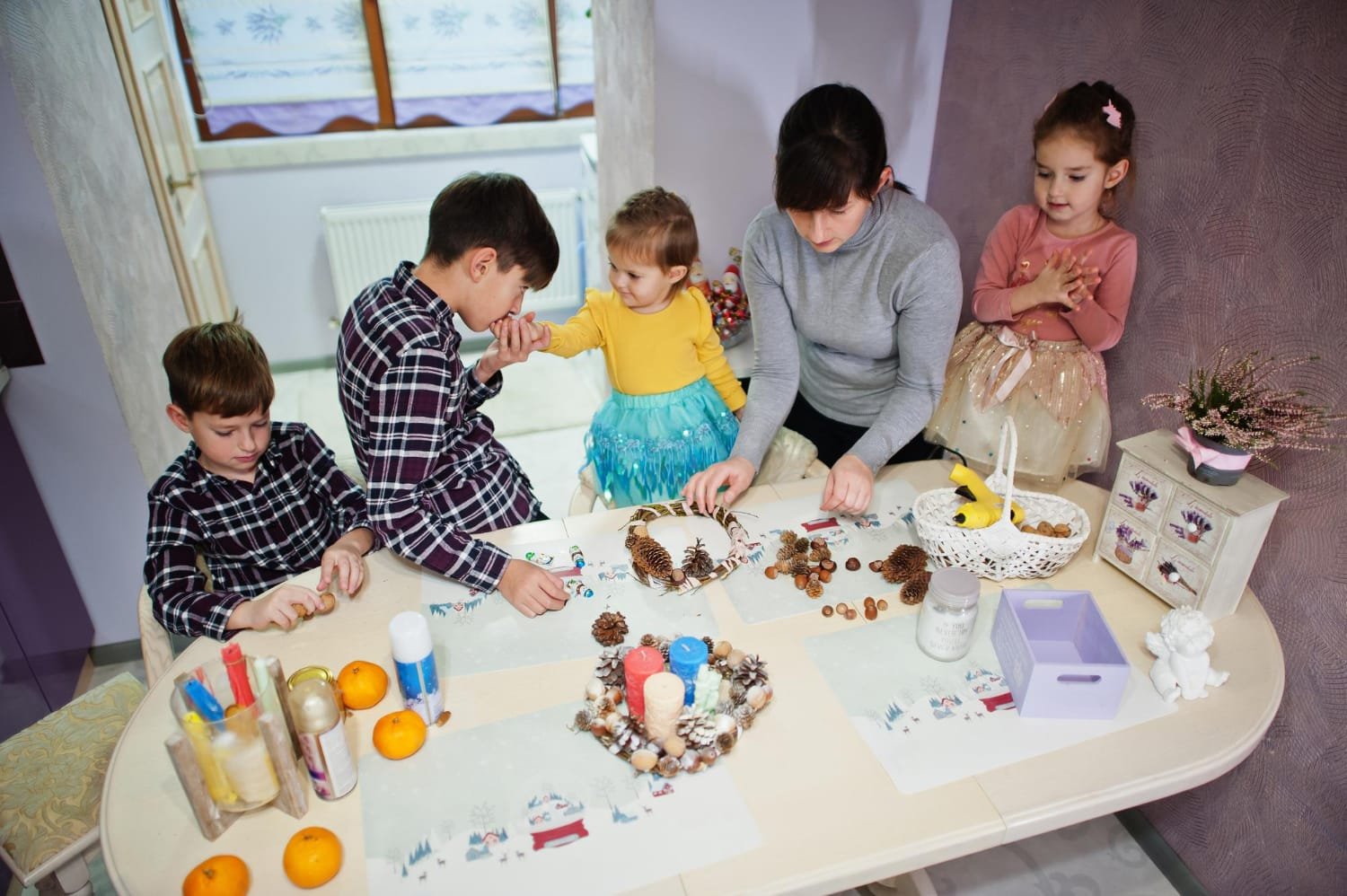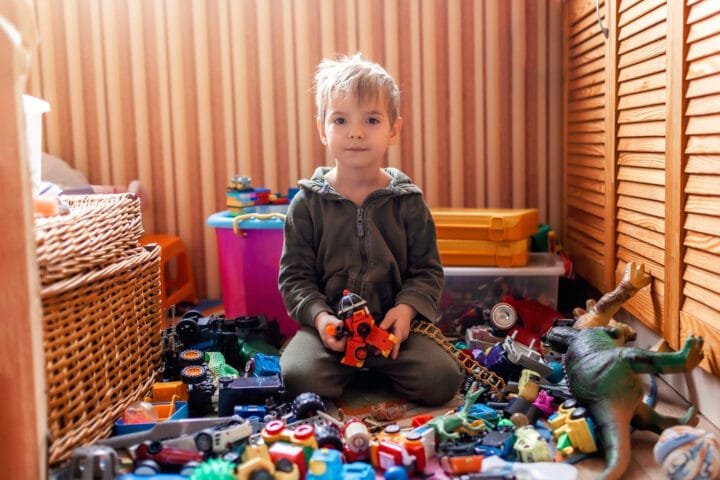Ditch the Screens! 20+ Epic Games to Play in the Woods and Reclaim Your Family’s Wild Side!
Ever feel like you’re competing with a screen for your child’s attention? You’re not alone. I’ve been there. It’s a constant battle, and honestly, it’s terrifying. Studies show that American children spend an average of 4 to 6 hours a day on screens. That’s more time than they spend doing anything else besides sleeping! Alarming, right? We’re raising a generation of digitally dependent kids, and it’s time to hit the brakes. I remember a time when “outside” was our playground, our sanctuary. We built forts, scraped our knees, and our imaginations ran wild. That’s the childhood I want for my kids. That’s the childhood they deserve. But how do we pull them away from the mesmerizing glow of their devices? My answer: Rediscover the magic of the woods and the simple joy of playing games to play in the woods!
Reconnecting with Nature: It’s More Than Just a Breath of Fresh Air
The Call of the Wild: Why Our Souls Crave Nature
There’s something primal, something deeply ingrained within us, that yearns for a connection with the natural world. Scientists call it “biophilia” – our innate human tendency to seek connections with nature. Think about it: We feel relaxed by the ocean and refreshed by a walk in the park. A study by the University of Michigan found that memory performance and attention spans improved by 20% after people spent an hour interacting with nature. It’s not just a feeling; it’s science! Nature nurtures us. When we’re immersed in it, our stress levels plummet. Our minds are clear. We breathe easier.
Play: It’s Not Just Kid Stuff Anymore
And playing? Oh, playing is vital! It’s not just for the little ones; it is crucial for all of us. We all need to play in our lives, regardless of our age. Play sparks creativity. It hones problem-solving skills and strengthens bonds with others. The woods are the ultimate playground, brimming with possibilities, begging to be explored. Dr. Stuart Brown, founder of the National Institute for Play, emphasizes that play is as crucial for adults as it is for children, contributing to happiness, cognitive flexibility, and stronger relationships. Ditch the rigid schedules and embrace spontaneity.
What This Guide Offers You
This isn’t just another list of games. This is your family’s roadmap to reclaiming joy, connection, and a little bit of wildness. We’ll dive into classic games reinvented for the forest. We’ll explore creative adventures and discover games that teach valuable lessons about the natural world. Get ready to unleash your inner child!
Classic Games: Reimagined for the Forest
Objective: To hide successfully from the “seeker” and avoid being found.
How to Play
Choose a Seeker: One person is designated as “It” or the seeker.
Define the Boundaries: Establish clear boundaries for the hiding area. This could be a section of the woods, a particular trail, or an area marked by natural landmarks.
Counting Time: The seeker closes their eyes and counts to a predetermined number (e.g., 20, 30, or higher) loudly enough for everyone to hear.
Hide! While the seeker is counting, the other players scatter and hide within the designated boundaries. Encourage creative hiding spots behind trees, under bushes, or even camouflaged with leaves (if appropriate and safe).
Seeking: Once the seeker finishes counting, they yell, “Ready or not, here I come!” and begin searching for the hiders.
Found You! When the seeker finds a hider, they call out their name. That person is then “caught.”
The Chase (Optional): You can add a rule that once a hider is spotted, they can try to run to a designated “safe zone” before the seeker tags them.
New Seeker: The first person found typically becomes the new seeker for the next round.
Objective: To capture the other team’s flag and bring it back to your side without getting tagged.
How to Play
Divide into Teams: Split the players into two even teams.
Define Territories: Use a natural boundary like a creek, a line of trees, or a trail to divide the playing area into two territories, one for each team.
Choose Flag Locations: Each team hides their “flag” (a bandana, a t-shirt, or any other object) somewhere within their territory.
Jail: Designate a “jail” area on each side. This could be a circle around a tree or a specific spot marked with sticks.
Gameplay: Players try to infiltrate the other team’s territory, capture their flag, and bring it back to their side without being tagged.
Getting Tagged: If a player is tagged while in the enemy’s territory, they go to the enemy’s jail.
Jailbreak: Players in jail can be freed if a teammate tags them without getting tagged themselves.
Winning: The first team to capture the other team’s flag and bring it back to their side wins.
Objective: To find all the items on a predetermined list of natural objects.
How to Play
Create a List: Before you start, prepare a list of items commonly found in the woods. You can tailor the list to the age and abilities of the players. Examples include:
- A specific type of leaf (e.g., oak leaf, maple leaf)
- A feather
- A smooth stone
- Something that smells good
- A pinecone
- A piece of bark
- A forked stick
- Something red
- Something round
Add Riddles (Optional): To make it more challenging, add riddles or clues to the list. For example, instead of “a red leaf,” you could write, “I turn bright colors in the fall and crunch under your feet. What am I?”
Set Boundaries: Define the area where the scavenger hunt will take place.
Search! Players search for the items on the list within the designated area.
Show and Tell: Once a player finds an item, they can show it to the leader or keep it in a bag or container.
Winner: The first person to find all the items on the list wins. Or, if you prefer a non-competitive version, everyone can work together to find all the items.
Objective: To avoid being tagged by the person who is “It.”
How to Play
Choose “It”: One person is designated as “It.”
Gameplay: “It” chases the other players, trying to tag them.
You’re It! If a player is tagged, they become the new “It.”
Variations: Freeze Tag: When a player is tagged, they must freeze in place until another player (who is not “It”) unfreezes them by tagging them.
TV Tag: When a player is tagged, they must freeze and can only be unfrozen if another player calls out the name of a TV show.
Cartoon Tag: Like a TV tag, players must call out the name of a cartoon character.
Objective: To reach the person who is “It” without being caught moving.
How to Play
Choose “It”: One person is “It” and stands at the far end of a clearing or designated area, facing away from the other players.
Starting Line: The other players line up at the opposite end of the area.
Green Light! While “It’s” back is turned, they yell, “Green light, 1, 2, 3!” and the other players can run or walk towards them.
Red Light! At any point, “It” can yell “Red light!” and quickly turn around.
Freeze! When “It” yells “Red light,” all players must immediately freeze in place.
Caught You! If “It” sees any player moving after they’ve called “Red light,” that player is out or must return to the starting line.
Winning: The first player to reach and tag “It” without being caught moving wins and becomes the new “It.”
Objective: To reach Mr. Fox without being tagged during “Dinner Time!”
How to Play
Choose Mr. Fox: Oe person is designated as Mr. Fox and stands at one end of the playing area.
Starting Line: The other players line up at the opposite end.
What Time Is It? The players chant in unison, “What time is it, Mr. Fox?”
Mr. Fox’s Reply: Mr. Fox replies with a time, such as “2 o’clock!” or “5 o’clock!”
Steps: The players then take the corresponding number of steps forward (2 steps for “2 o’clock,” 5 steps for “5 o’clock,” etc.).
Dinner Time! At any point, instead of stating a time, Mr. Fox can yell, “Dinner time!”
The Chase: Mr. Fox then turns around and chases the players back to the starting line.
New Mr. Fox: If Mr. Fox tags a player before they reach the starting line, that player becomes the new Mr. Fox.
Objective: To collaboratively create a story inspired by nature.
How to Play
Storytelling Chain: Gather in a Circle: Everyone sits in a circle.
Starting Sentence: One person begins the story with a sentence, such as “Deep in the woods lived a little brown rabbit.”
Adding On: The next person adds another sentence to the story, and so on around the circle.
Encourage Creativity: Encourage players to use their imaginations and incorporate elements of the forest into the story.
Nature Prompts: Choose a Prompt: Select a natural element as inspiration, such as an old tree, a babbling brook, a bird’s nest, or a particular animal.
Start the Story: One person begins a story based on the chosen prompt. For example, “The wise old owl who lived in the tallest oak tree had seen many things…”
Continue the Story: Others can take turns adding to the story, or everyone can contribute ideas together.
Creative and Imaginative Woodland Adventures: Unleash the Magic
Objective: To construct a shelter or play space using natural materials found in the woods.
How to Play
Find a Location: Look for a suitable spot, such as a clearing, a space between trees, or a natural hollow.
Gather Materials: Collect fallen branches, sticks, leaves, and other natural materials. Important: Only use materials that have already fallen to the ground. Do not break branches off of living trees.
Design Your Fort: Decide what type of fort you want to build. Some ideas include:
Lean-to: A simple structure made by leaning branches against a tree or large rock.
Teepee: A cone-shaped structure made by tying branches together at the top and spreading them out at the base.
A-Frame: Two sets of branches leaned against each other to create an A-shape.
Construction: Start building your fort, using the larger branches for the frame and smaller branches and leaves for walls and roofing.
Safety: Make sure the structure is stable before entering it.
Avoid using rotten or weak branches.
Supervise children closely during the building process.
Objective: To create art using natural materials found in the woods.
How to Play
Gather Materials: Collect interesting natural objects like leaves, flowers, twigs, stones, pinecones, bark, and moss.
Land Art: Create Designs: Arrange the materials on the ground to create patterns, pictures, or abstract designs. Think of it like drawing with nature.
Temporary Art: Remember that land art is usually temporary. Enjoy the process of creating it, and then let it return to nature.
Nature Paintbrushes: Find Twigs: Look for small twigs or sticks.
Attach Natural Materials: Tie or wrap soft materials like moss, leaves, or flower petals to one end of the twig to create a brush.
Natural Pigments: Experiment with Colors: Try crushing berries, flowers, or colored (if available and safe) to create natural pigments.
Mud Paint: Mix mud with water to create a simple paint.
Leave No Trace: When you’re finished, either leave your art to decompose naturally (if appropriate) or dismantle it and scatter the materials.
Objective: To navigate a course made of natural obstacles.
How to Play
Find a Suitable Area: Choose a section of the woods with a variety of natural features.
Design the Course: Use the existing terrain and natural elements to create obstacles. Some ideas include:
- Log Balance: Walk across a fallen log.
- Rock Hop: Hop from one rock to another.
- Branch Crawl: Crawl under low-hanging branches.
- Hill Climb: Climb up and down a small hill.
- Stream Jump: Jump over a narrow stream or creek (if safe).
- Tree Weave: Weave in and out of a series of trees.
Safety: Make sure the obstacles are safe and appropriate for the age and abilities of the participants.
Clear away any hazards like sharp sticks or loose rocks.
Supervise children closely.
Timed Runs (Optional): Time each person as they complete the course.
Variations: Team Challenge: Have teams work together to complete the course.
Relay Race: Divide into teams and have each person complete a section of the course before tagging the next person.
Objective: To build tiny houses for imaginary forest creatures.
How to Play
Gather Materials: Collect small natural objects like twigs, moss, bark, pebbles, flower petals, leaves, and acorn caps.
Find a Location: Look for a cozy spot, such as the base of a tree, a mossy patch, or a slight hollow.
Build the House: Use the materials to construct a miniature dwelling. You can create walls, roofs, doors, windows, and even tiny furniture.
Use Your Imagination: Let your creativity run wild! There are no rules when it comes to building fairy or elf houses.
Tell a Story: Make up stories about the creatures who might live in your houses.
Objective: To invent a new game using only natural materials and the forest environment.
How to Play
Brainstorm: Get together and discuss ideas for a new game. Think about what you enjoy doing in the woods and what materials are available.
Develop Rules: Once you have a basic idea, create a set of rules. Consider:
What is the objective of the game?
How many players are needed?
What materials will be used?
How do you win or lose?
Test and Refine: Play the game a few times and make adjustments to the rules as needed.
Name Your Game: Come up with a creative name for your new game.
Objective: To improve observation skills and focus on details.
How to Play
Find a Stick: Each person finds a stick in the woods that they find interesting.
Examine Closely: Everyone spends a few minutes carefully examining their stick, noting its size, shape, color, texture, and any unique features. Encourage the use of all senses (except taste!).
Stick Pile: All the sticks are collected and placed in a pile in the center of the group.
Mix Them Up: The sticks are mixed up so that their original owners are not prominent.
Find Your Stick: Each person tries to identify their stick from the pile based on their observations.
Discussion: After everyone has found (or attempted to find) their stick, discuss what features helped them identify it.
Objective: To create music using sounds and rhythms found in nature.
How to Play
Gather Instruments: Collect natural items that can be used to make sounds. Some ideas include:
Hollow Reeds or Bamboo Can be used as flutes or whistles.
Stones: Can be clicked or tapped together.
Sticks: Can be used as drumsticks or rhythm sticks.
Dried Seed Pods or Gourds Can be used as shakers or rattles.
Pinecones: Can be scraped together to create a rasping sound.
Experiment with Sounds: Explore the different sounds that each item makes.
Create Rhythms: Practice creating different rhythms by tapping, shaking, or scraping the instruments.
Compose a Song: Work together to create a “forest symphony” by combining different sounds and rhythms.
Perform! Share your musical creations.
Games that Teach and Connect: Learning Through Play
Objective: To spot various natural items listed on a bingo card.
How to Play
Create Bingo Cards: Before you go, make bingo cards with a grid (e.g., 5×5) on each. In each square, write or draw a picture of something commonly found in the woods. Examples include:
A specific type of tree (e.g., oak, pine, maple)
A bird
An insect
A spider web
A feather
A pinecone
A flower
A rock with a unique shape or color
Animal tracks
Distribute Cards and Markers: Give each player a bingo card and something to mark the squares with (e.g., small stones, acorns, or leaves).
Explore and Observe: As you walk through the woods, players look for the items on their bingo cards.
Bingo! When a player finds an item, they mark it off on their card. The first person to get five in a row (horizontally, vertically, or diagonally) yells, “Bingo!”
Variations: Themed Bingo: Create bingo cards with specific themes, such as “Birds of the Forest,” “Forest Flowers,” or “Signs of Autumn.”
Non-competitive Bingo: Everyone works together to find all the items on a single card.
Objective: To develop listening skills and awareness of the sounds of nature.
How to Play
Find a Quiet Spot: Choose a place in the woods where you can sit comfortably and undisturbed.
Close Your Eyes: Everyone closes their eyes and sits silently for a few minutes, focusing on the sounds around them.
Create a Sound Map: Provide each person with a piece of paper and something to draw with.
Draw the Sounds: Have them draw a simple map, with an “X” in the center representing their location. As they hear different sounds, they mark them on the map in the direction they came from and try to describe the sound with a symbol or drawing. For example:
A bird singing in a tree to the east might be represented by a musical note drawn on the right side of the map.
Wavy lines on the left side of the map might represent the sound of a stream flowing to the west.
Rustling leaves might be drawn as little leaf shapes.
Share and Discuss: After a designated time (e.g., 5-10 minutes), have everyone open their eyes and share their sound maps. Discuss the different sounds you heard and what might have made them.
Objective: To learn to identify animal tracks and signs and understand animal behavior.
How to Play
Learn the Basics: Before you go, familiarize yourself with the tracks of common animals in your area. A good field guide or website can be helpful. Some common animals to look for include:
Deer
Raccoons
Squirrels
Rabbits
Birds
Dogs/Coyotes/Foxes
Find a Good Spot: Look for areas with soft sand or mud where tracks are more likely to be visible. Areas near water sources are often good places to find tracks.
Examine the Tracks: When you find tracks, look closely at their size, shape, and the number of toes.
Use a Field Guide: Compare the tracks you find to the pictures and descriptions in your field guide to try to identify the animal that made them.
Look for Other Signs: In addition to tracks, look for other signs of animal activity, such as:
Scat (droppings)
Fur or feathers
Scratch marks on trees
Nests or burrows
Evidence of feeding (e.g., chewed plants, acorn shells)
Tell a Story: Use the tracks and other signs to piece together a story about what the animal might have been doing. Where was it going? What was it eating? Was it alone or with others?
Objective: To appreciate the textures of leaves and bark and learn to identify different tree species.
How to Play
Gather Materials: You’ll need:
Paper (thin paper works best)
Crayons (with the paper removed) or soft pencils
A collection of different leaves and pieces of bark (make sure it is ethical and sustainable to collect these; only take fallen leaves and bark)
Place Under Paper: Place a leaf or piece of bark under a sheet of paper.
Rub with Crayon/Pencil: Hold the paper firmly in place and rub the side of a crayon or soft pencil over the area where the leaf or bark is underneath. The texture of the leaf or bark will be transferred to the paper.
Experiment with Colors: Try using different colors to create various effects.
Identify the Trees: If possible, use a field guide to identify the trees from which the leaves and bark came.
Create a Nature Journal: You can create a collection of leaf and bark rubbings in a nature journal, along with notes about where you found them and the date.
Objective: To relax, observe the clouds, and use your imagination.
How to Play
Find a Comfortable Spot: Choose a transparent or open area where you have a good view of the sky.
Lie Back and Relax: Lie down on a blanket or directly on the ground if it’s comfortable.
Observe the Clouds: Look up at the clouds and watch as they move and change shape.
Find Shapes and Pictures: Use your imagination to find shapes, figures, or pictures in the clouds. Do you see animals, faces, objects, or anything else?
Share Your Observations: Take turns sharing what you see in the clouds.
Tell Stories: Create stories based on the shapes you see in the clouds.
Objective: To practice observation skills and capture the beauty of nature through photography.
How to Play
Equipment: Each participant needs a camera or a phone with a camera.
Set a Theme: Choose a theme for the photography challenge. Some ideas include:
- Patterns in Nature: Look for repeating patterns in leaves, bark, flowers, etc.
- Tiny Wonders: Focus on small details, such as insects, moss, or dewdrops.
- Colors of the Forest: Capture the different colors found in the woods.
- Light and Shadow: Play with the way light and shadow interact in the forest.
- Textures of Nature
Time Limit: Set a time limit for taking photos (e.g., 30 minutes, 1 hour).
Explore and Photograph: Everyone explores the area and takes photos that fit the chosen theme.
Share and Discuss: After the time is up, gather and share your photos. Discuss what you found interesting, challenging, or beautiful.
Optional: You can even create a slideshow or print out the photos to create a nature photography exhibit.
Objective: To heighten awareness of non-visual senses and build trust.
How to Play
Choose a Safe Area: Select a relatively flat, open area of the woods that is free of obstacles like low branches, dense undergrowth, and steep slopes.
Pairs: Divide into pairs. One person will be blindfolded, and the other will be the guide.
Blindfold: One person puts on a blindfold or closes their eyes tightly.
Guide: The guide carefully and slowly leads the blindfolded person on a short walk through the designated area.
Focus on Senses: The guide encourages the blindfolded person to focus on their other senses:
- Sounds: What sounds do you hear? Birds, wind, rustling leaves?
- Smells: What do you smell? Pine needles, damp earth, flowers?
- Textures: What do you feel under your feet? What do you think when you touch trees or leaves (with guidance)?
Verbal Guidance: The guide provides clear verbal directions and descriptions to help the blindfolded person navigate safely and understand their surroundings.
Switch Roles: After a set time (e.g., 5-10 minutes), switch roles so that each person has a chance to be the guide and the blindfolded walker.
Discussion: After the activity, discuss the experience. How did it feel to rely on your other senses? What did you notice that you might not have seen with your eyes open?
Objective: To cultivate gratitude and appreciation for nature.
How to Play
Find Rocks: Each person finds a small, smooth rock in the woods.
Reflect on Gratitude: Take a few moments to think about things you are grateful for, particularly related to nature. It could be the beauty of the forest, the fresh air, the sounds of birds, or a specific experience you had in nature.
Decorate (Optional): If you have paint, markers, or other decorative materials, you can decorate your rock with words, symbols, or pictures that represent what you are grateful for. You can also do this with just the rock as is.
Share (Optional): If comfortable, share what you wrote or drew on your rock and why you are grateful for it.
Place Rocks: Find a special spot in the woods to place your gratitude rocks. You can create a small pile or arrange them in a pattern. This creates a physical reminder of your appreciation for nature.
Revisit: You can revisit the spot-on future trips to the woods and add more gratitude rocks.
Preparing for Your Woodland Adventure: Be Prepared, Stay Safe
Safety First: Essential Precautions
- Check the weather: Before you go, check the weather forecast and dress accordingly. Be prepared for changes in weather, especially if you’ll be out for a long time.
- Dress in layers: This allows you to adjust to changing temperatures.
- Wear appropriate footwear: Sturdy, closed-toe shoes or hiking boots are recommended, especially if you’re walking on uneven terrain.
- Hydration and Food: Pack plenty of water and snacks to keep your energy up.
- First-Aid Kit: Bring a basic first-aid kit with essentials like bandages, antiseptic wipes, pain relievers, and any personal medications.
- Insect Repellent: Depending on the location and time of year, insect repellent may be necessary to protect against mosquitoes, ticks, and other biting insects.
- Sun Protection: Wear sunscreen, a hat, and sunglasses to protect yourself from the sun, even on cloudy days.
- Navigation: If you’re venturing into unfamiliar territory, bring a map and compass or a GPS device. Let someone know your plans, including where you’re going and when you expect to be back.
- Wildlife Awareness: Be aware of the potential for encountering wildlife, such as snakes, bears, or other animals. Learn about the animals in your area and how to react if you encounter them. Maintain a safe distance and never approach or feed wild animals.
- Poison Ivy/Oak/Sumac: Learn to identify these plants and avoid contact with them. If you do meet them, wash the affected area with soap and water as soon as possible.
Leave No Trace: Respecting the Forest
- Pack it in, pack it out: Carry out all trash, leftover food, and litter.
- Dispose of waste properly: If you need to use the bathroom, do so at least 200 feet away from water sources.
- Leave what you find: Leave rocks, plants, and other natural objects as you found them. Avoid disturbing or removing them.
- Minimize campfire impacts: If you build a campfire (where permitted), keep it small and contained. Use existing fire rings if available. Make sure the fire is completely extinguished before leaving.
- Respect wildlife: Observe animals from a distance. Do not follow, approach, or feed them.
- Be considerate of other visitors: Keep noise levels down and be mindful of others who are also enjoying the forest.
Gear Up: What to Bring (Optional)
- Binoculars: For birdwatching or observing wildlife from a distance.
- Magnifying glass: For examining small details like insects, flowers, and moss.
- Field guides: These are to help you identify plants, animals, tracks, and other natural features.
- Camera or phone: To capture memories and document your discoveries.
- Nature journal and pencils/pens: To record your observations, sketches, and thoughts.
- Small backpack: To carry your gear and supplies.
- Whistle: This is for signaling in case of emergency.
- Small trowel: For burying human waste properly if needed.
Choosing the Right Location
- Public Parks and Forests: Check the websites of state parks, national forests, or local parks for information on trails, facilities, and regulations.
- Nature Preserves: These areas are often managed for conservation and may have specific guidelines for visitors.
- Your Backyard: If you have a wooded area on your property, it can be a convenient and safe place to start exploring.
- Consider Accessibility: Choose a location that is appropriate for the age and physical abilities of everyone in your group. Some trails are more challenging than others.
- Difficulty Level: Start with shorter, easier trails and gradually work your way up to longer, more difficult ones as you gain experience and confidence.
Finding the Time
- Schedule it: Block out time on your calendar for outdoor play, just as you would for any other important activity.
- Make it a regular event: Aim for weekly or bi-weekly outings to make it a consistent part of your family’s routine.
- Involve the whole family: Let everyone participate in choosing the location and activities. This will help build excitement and make it more likely that everyone will enjoy the experience.
- Be flexible: Don’t be afraid to adjust your plans based on the weather, energy levels, or unexpected discoveries. The most important thing is to have fun and enjoy the time together in nature.
By following these guidelines and using a little bit of planning, you can create memorable and enriching experiences playing games in the woods with your family. Remember that the goal is to connect with nature, have fun, and foster a lifelong love and respect for the natural world.
Conclusion: Embrace the Wild; Embrace the Joy! Let’s Do This!
We’ve lost touch with something vital, something essential to our well-being: the simple, profound joy of playing in nature. It’s time to reclaim it for ourselves and our children. These games to play in the woods are more than just activities; they are an invitation. An invitation to reconnect, to explore, to discover the magic that’s been waiting for us all along right outside our doors. So, ditch the screens, lace up your shoes, and let the adventure begin!
Let’s raise a generation that values scraped knees and muddy hands as much as high scores and virtual rewards. Let’s raise wild, free, and happy kids! You’ll be glad you did. The memories you create will last a lifetime.
Recommend Books
Last Child in the Woods: Saving Our Children from Nature-Deficit Disorder by Richard Louv
This is a seminal work that explores the importance of nature for children’s well-being and development. It directly addresses the issue of “nature-deficit disorder” and provides a compelling argument for getting kids back outside and connected with the natural world. The book aligns perfectly with the article’s core message.
How to Raise a Wild Child: The Art and Science of Falling in Love with Nature by Scott D. Sampson
This book provides a practical, science-backed guide for parents who want to cultivate a deep connection with nature in their children. It offers a framework for outdoor exploration and play, making it a perfect companion to the article’s game suggestions.
This book emphasizes the importance of free, unstructured play in nature for children’s physical, cognitive, and emotional development. It highlights the benefits of outdoor play for sensory integration, motor skills, and risk assessment, all of which are engaged in the games described in the article.
The Nature Principle: Reconnecting with Life in a Virtual Age by Richard Louv
While Last Child in the Woods focuses on children, this book by the same author extends the concept of nature’s connection to adults. It explores how re-engaging with nature can enhance creativity, health, and well-being for people of all ages. The article promotes family play, and this book reinforces the idea that nature is beneficial for everyone.
Coyote’s Guide to Connecting with Nature by Jon Young, Ellen Haas, and Evan McGown
This book provides a comprehensive framework for nature mentoring and deep nature connection. It offers a wealth of activities, games, and awareness exercises that can be used to enhance the experience of playing in the woods. It complements the article by providing a more structured approach to nature education through play.
FAQs
Playing games in the woods offers a wealth of benefits for children that go far beyond just having fun! It’s like a super-boost for their development. Firstly, it gets them active and moving, improving their physical health, coordination, and balance. Think of it as nature’s gym! Secondly, it sparks their creativity and imagination as they use natural materials to play and invent their games. Thirdly, it teaches them valuable problem-solving skills, whether they’re building a fort or navigating an obstacle course. Plus, it fosters a deep connection with nature, encouraging them to appreciate and respect the environment. Finally, playing with others outdoors helps build social skills, teamwork, and communication, all in a fun and natural setting. Spending time in nature has also been shown to reduce stress and improve focus in children. It’s a win-win!
The beauty of these games is their adaptability! While the article features 20+ games, many can be modified to suit different age groups and abilities. Simple games like hide-and-seek, scavenger hunts, and nature art are perfect for younger children (ages 3-6), while older kids (ages 7-12) might enjoy more complex games like Capture the Flag, fort building, and animal tracking. Teenagers could even enjoy creating their own games and photography challenges or leading younger children. The key is to choose games that are appropriate for the developmental stage of the children involved and to adjust the rules and difficulty as needed. Grown-ups can join in, too. Remember, the goal is to have fun and enjoy the experience together!
Preparation is key to a safe and enjoyable day in the woods! First, check the weather forecast and dress in layers, considering appropriate footwear like closed-toe shoes. Pack essentials like water, snacks, a basic first-aid kit, sunscreen, and insect repellent. It is also essential to be aware of your surroundings and teach children about potential hazards like poison ivy or ticks. If you’re venturing into an unfamiliar area, bring a map and compass and let someone know your plans. Lastly, embrace the “Leave No Trace” ethic – pack out everything you pack in and respect the natural environment. A little planning goes a long way in ensuring a fantastic outdoor adventure!
Absolutely! While a sprawling forest is ideal, you can adapt many of these games to different natural settings. A local park with a wooded area, a nature trail, a large backyard with trees, or even a green space with bushes and shrubs can work. The key is to get creative and use the natural elements available to you. You might be surprised at the possibilities! For example, you can still have a scavenger hunt, build a mini-fort, create nature art, or play games like tag or “What Time is it, Mr. Fox?” in a smaller, more contained natural area. The spirit of these games is about connecting with nature and having fun wherever you may be.
That’s a common challenge in today’s digital age. Start by making it a family affair – children are more likely to be enthusiastic if they see you participating and having fun. Introduce the games gradually. Begin with shorter outings and simpler games, and let their interest guide you. You can also pique their interest by showing them pictures of the activities or involving them in the planning process, like creating a scavenger hunt list or choosing a fort-building spot. Highlight the adventurous aspects, like becoming a nature detective while tracking animals or building a secret hideout.
Most importantly, be patient and persistent. It may take time to shift their habits, but the rewards of unplugged, nature-based play are well worth the effort! Remember, the goal is to foster a love for nature and create positive associations with outdoor play.
Related Posts













































































